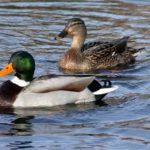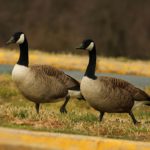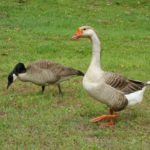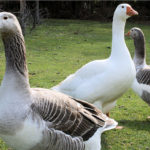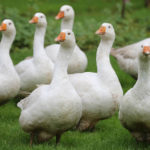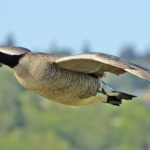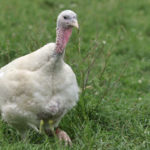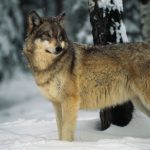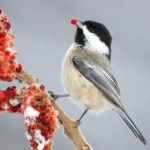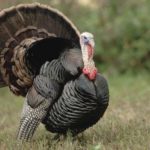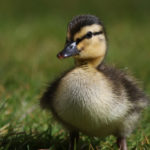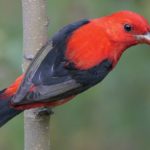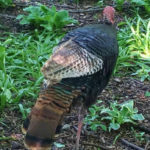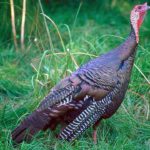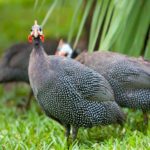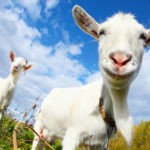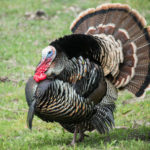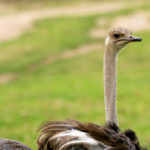Geese
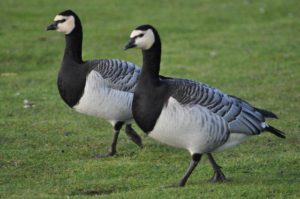 Geese – one of the largest domesticated birds, inferior in size only to turkeys. Their numbers are much lower than the number of other poultry, but at the same time in agriculture they occupy a special “privileged” position.
Geese – one of the largest domesticated birds, inferior in size only to turkeys. Their numbers are much lower than the number of other poultry, but at the same time in agriculture they occupy a special “privileged” position.
Among other birds, domestic geese differ in that they occur immediately from several wild species. The greatest influence on their rock formation was rendered by wild gray geese, living everywhere in the expanses of Eurasia. It is from this species that the overwhelming majority of modern breeds occur. In the East, some breeds originate from the wild goose frog, inhabiting Asia and not found in Europe. Finally, in northern regions of Europe several local little-known breeds were obtained by hybridization of domestic geese with wild white-fronted goose dwelling in the tundra.
Domestication of geese was rather unusual. These birds do not have a single domicile of domestication, this process took place simultaneously in different parts of Europe and Asia. Domestication of geese occurred much later than the domestication of chickens, ducks, pigeons – it happened about 3000 years ago. If domestication of other domestic birds was confined to southern warm regions, then geese were primarily domesticated in the north. The most ancient foci of domestication are found on the territory of modern Germany, on the coasts of the Baltic and North Seas, around the same time geese were domesticated (irrespective of the Germans) in Ancient Greece and Rome, China.
From these outbreaks domestic geese gradually spread to neighboring countries, then the zone of their spread covered the whole of Eurasia. In the colonial period, geese were brought to other continents, but there was not much popularity there. Now the highest number of geese is still observed in the areas of historical domestication – Northern and Western Europe, slightly less in Asia, Italy, Eastern Europe, relatively few in the US, in the remaining countries geese are few.
The reason for this unusual domestication lies in the way of life of geese. These birds are herbivores, so they get most of the feed themselves and do not need feeding. And if so, then the commonwealth with the person of special benefit to these birds does not carry, unlike hens and ducks, adult geese did not approach the dwellings of ancient people. But the man was very interested in obtaining such an advantageous source of meat, so the first domestic geese were not lured to dwellings, but simply caught the chicks for further fattening.
Since the mass nesting of geese occurred in the meadows of Northern Europe, the domestication here occurred earlier than other regions. Geese in captivity were tied to their master … with their intellect. Being very intelligent birds with pronounced monogamy, geese tend to remain faithful both to their educator and to their nesting partner. These qualities of geese were noticed already in antiquity, therefore geese were respected by the ancient Greeks, and the Romans identified these birds with the goddess Juno, the guardian of the family hearth and marriage faithfulness. Near the temple of the goddess on the Capitol consistently kept a herd of sacred geese, it was these birds that woke their guards at night with guards, when the Gauls attacked Rome. From here comes the saying “the geese Rome saved”.
Modern breeds of geese have reached a great variety, some of them have preserved the habits of wild ancestors, others in the way of life have significantly evaded them. Perhaps, they are united only by the fact that they all can not fly or do it extremely badly. When keeping geese, it is worth remembering that they are waterfowl birds, so they need water more or less. However, in comparison with ducks geese are tied to reservoirs much less. If the ducks are looking for most of the food in the water, the geese, on the contrary, feed mainly on the shore, and in the water they are more likely to look for feeding.
In general, two methods of keeping geese are practiced in agriculture. The first way is free grazing. In this case, geese are kept at night in the poultry house, and in the morning they are let out to the meadow or pond where they spend the whole day. This method is the lowest cost, it is used in small households, especially in areas of primitive poultry farming. But sometimes this method is also practiced on large farms that have appropriate ponds or pastures.
